Regulatory Information
GLAXOSMITHKLINE PTE LTD
GLAXOSMITHKLINE PTE LTD
Therapeutic
Prescription Only
Formulation Information
TABLET
**Dosage and Administration** Pharmaceutical form: Tablets and Dispersible/Chewable tablets. _LAMICTAL_ tablets should be swallowed whole, and should not be chewed or crushed. _LAMICTAL_ dispersible/chewable tablets may be chewed, dispersed in a small volume of water (at least enough to cover the whole tablet) or swallowed whole with a little water. DO NOT attempt to administer partial quantities of the dispersible/chewable tablets. If a calculated dose of _LAMICTAL_, e.g. for use in children (epilepsy only) or patients with hepatic impairment, cannot be divided into multiple lower strength tablets, the dose to be administered is that equal to the nearest lower strength of whole tablets. It is strongly recommended that therapy with lamotrigine is initiated at the recommended doses. Careful incremental titration of the dose may decrease the severity of skin rashes. There are suggestions, yet to be proven, that the risk of severe, potentially life-threatening rash may be increased by co-administration of _LAMICTAL_ with valproate. However, cases have been reported in the absence of these factors. Therefore, it is important that the dosing recommendations be followed closely. **Restarting Therapy** Prescribers should assess the need for escalation to maintenance dose when restarting _LAMICTAL_ in patients who have discontinued _LAMICTAL_ for any reason, since the risk of serious rash is associated with high initial doses and exceeding the recommended dose escalation for _LAMICTAL_ (see _Warnings and Precautions_ – _please refer to the Product Insert/Patient Information Leaflet published on HSA for the full drug information_). The greater the interval of time since the previous dose, the more consideration should be given to escalation to the maintenance dose. When the interval since discontinuing _LAMICTAL_ exceeds five half-lives (see _Pharmacokinetics_ – _please refer to the Product Insert/Patient Information Leaflet published on HSA for the full drug information_), _LAMICTAL_ should generally be escalated to the maintenance dose according to the appropriate schedule. It is recommended that _LAMICTAL_ not be restarted in patients who have discontinued due to rash associated with prior treatment with _LAMICTAL_ unless the potential benefit clearly outweighs the risk. **EPILEPSY** When concomitant anti-epileptic drugs are withdrawn to achieve _LAMICTAL_ monotherapy or other AEDs are added on to treatment regimes containing lamotrigine, consideration should be given to the effect this may have on lamotrigine pharmacokinetics (see _Interactions_ – _please refer to the Product Insert/Patient Information Leaflet published on HSA for the full drug information_). - **Adults and Adolescents (over 12 years of age) (see Table 1)** **Dosage in Epilepsy Monotherapy** The initial _LAMICTAL_ dose in monotherapy is 25 mg once a day for two weeks, followed by 50 mg once a day for two weeks. Thereafter, the dose should be increased by a maximum of 50 to 100 mg every one to two weeks until the optimal response is achieved. The usual maintenance dose to achieve optimal response is 100 to 200 mg/day given once a day or as two divided doses. Some patients have required 500 mg/day of _LAMICTAL_ to achieve the desired response. Because of a risk of rash, the initial dose and subsequent dose escalation should not be exceeded (see _Warnings and Precautions_ – _please refer to the Product Insert/Patient Information Leaflet published on HSA for the full drug information_). **Dosage in Epilepsy Add-On Therapy** In patients taking valproate with/without any other AED, the initial _LAMICTAL_ dose is 25 mg every alternate day for two weeks, followed by 25 mg once a day for two weeks. Thereafter, the dose should be increased by a maximum of 25 to 50 mg every one to two weeks until the optimal response is achieved. The usual maintenance dose to achieve optimal response is 100 to 200 mg/day given once a day or in two divided doses. In those patients taking concomitant AEDs or other medications (see _Interactions_ – _please refer to the Product Insert/Patient Information Leaflet published on HSA for the full drug information_) that induce lamotrigine glucuronidation with/without other AEDs (except valproate), the initial _LAMICTAL_ dose is 50 mg once a day for two weeks, followed by 100 mg/day given in two divided doses for two weeks. Thereafter, the dose should be increased by a maximum of 100 mg every one to two weeks until the optimal response is achieved. The usual maintenance dose to achieve optimal response is 200 to 400 mg/day given in two divided doses. Some patients have required 700 mg/day of _LAMICTAL_ to achieve the desired response. In those patients taking other medications that do not significantly inhibit or induce lamotrigine glucuronidation (see _Interactions_ – _please refer to the Product Insert/Patient Information Leaflet published on HSA for the full drug information_), the initial _LAMICTAL_ dose is 25 mg once a day for two weeks, followed by 50 mg once a day for two weeks. Thereafter, the dose should be increased by a maximum of 50 to 100 mg every one to two weeks until the optimal response is achieved. The usual maintenance dose to achieve an optimal response is 100 to 200 mg/day given once a day or as two divided doses. 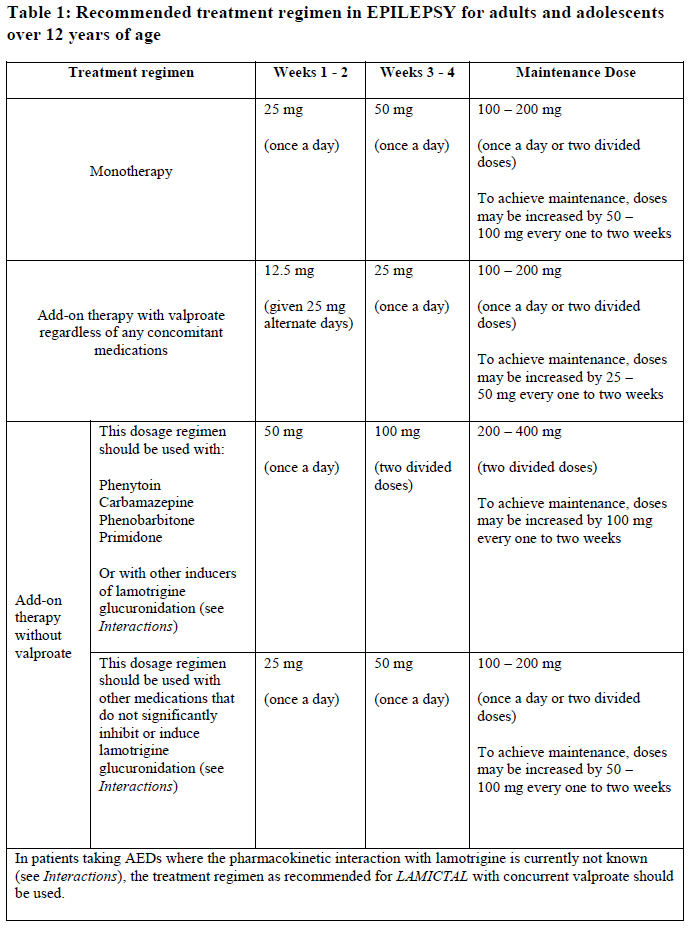 Because of a risk of rash the initial dose and subsequent dose escalation should not be exceeded (see _Warnings and Precautions_ – _please refer to the Product Insert/Patient Information Leaflet published on HSA for the full drug information_). - **Children (2 to 12 years of age) (see Table 2)** In patients taking valproate with/without any other AED, the initial _LAMICTAL_ dose is 0.15 mg/kg bodyweight/day given once a day for two weeks, followed by 0.3 mg/kg/day once a day for two weeks. Thereafter, the dose should be increased by a maximum of 0.3 mg/kg every one to two weeks until the optimal response is achieved. The usual maintenance dose to achieve optimal response is 1 to 5 mg/kg/day given once a day or in two divided doses, with a maximum of 200 mg/day. In those patients taking concomitant AEDs or other medications (see _Interactions_ – _please refer to the Product Insert/Patient Information Leaflet published on HSA for the full drug information_) that induce lamotrigine glucuronidation with/without other AEDs (except valproate), the initial _LAMICTAL_ dose is 0.6 mg/kg bodyweight/day given in two divided doses for two weeks, followed by 1.2 mg/kg/day given in two divided doses for two weeks. Thereafter, the dose should be increased by a maximum of 1.2 mg/kg every one to two weeks until the optimal response is achieved. The usual maintenance dose to achieve optimal response is 5 to 15 mg/kg/day given once a day or in two divided doses, with a maximum of 400 mg/day. To ensure a therapeutic dose is maintained the weight of a child must be monitored and the dose reviewed as weight changes occur. 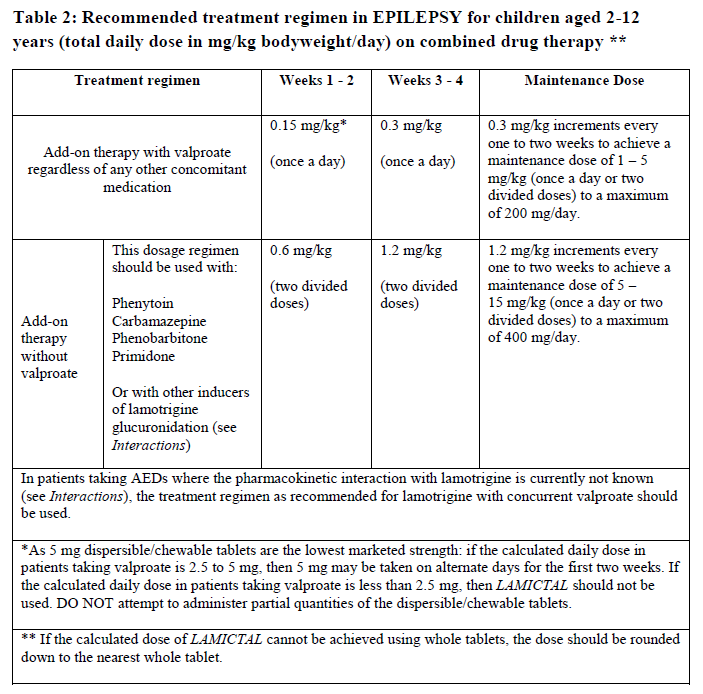 Because of a risk of rash the initial dose and subsequent dose escalation should not be exceeded (see _Warnings and Precautions_ – _please refer to the Product Insert/Patient Information Leaflet published on HSA for the full drug information_). It is likely that patients aged two to six years will require a maintenance dose at the higher end of the recommended range. - **Children aged less than 2 years** Lamotrigine has not been studied as monotherapy in children less than 2 years of age or as add-on therapy in children less than 1 month of age. The safety and efficacy of lamotrigine as add-on therapy of partial seizures in children aged 1 month to 2 years has not been established (see _Clinical Studies_ – _please refer to the Product Insert/Patient Information Leaflet published on HSA for the full drug information_). Therefore, _LAMICTAL_ is not recommended in children less than 2 years of age. **BIPOLAR DISORDER** - **Adults (18 years of age and over)** Because of the risk of rash the initial dose and subsequent dose escalation should not be exceeded (see _Warnings and Precautions_ – _please refer to the Product Insert/Patient Information Leaflet published on HSA for the full drug information_). _LAMICTAL_ is recommended for use in bipolar patients at risk for a future depressive episode. The following transition regimen should be followed to prevent recurrence of depressive episodes. The transition regimen involves escalating the dose of _LAMICTAL_ to a maintenance stabilisation dose over six weeks (see Table 3) after which other psychotropic and/or anti-epileptic drugs can be withdrawn, if clinically indicated (see Table 4). Adjunctive therapy should be considered for the prevention of manic episodes, as efficacy with _LAMICTAL_ in mania has not been conclusively established. There is no evidence of an increased risk of mania, hypomania or mixed type episodes with lamotrigine treatment compared to placebo. 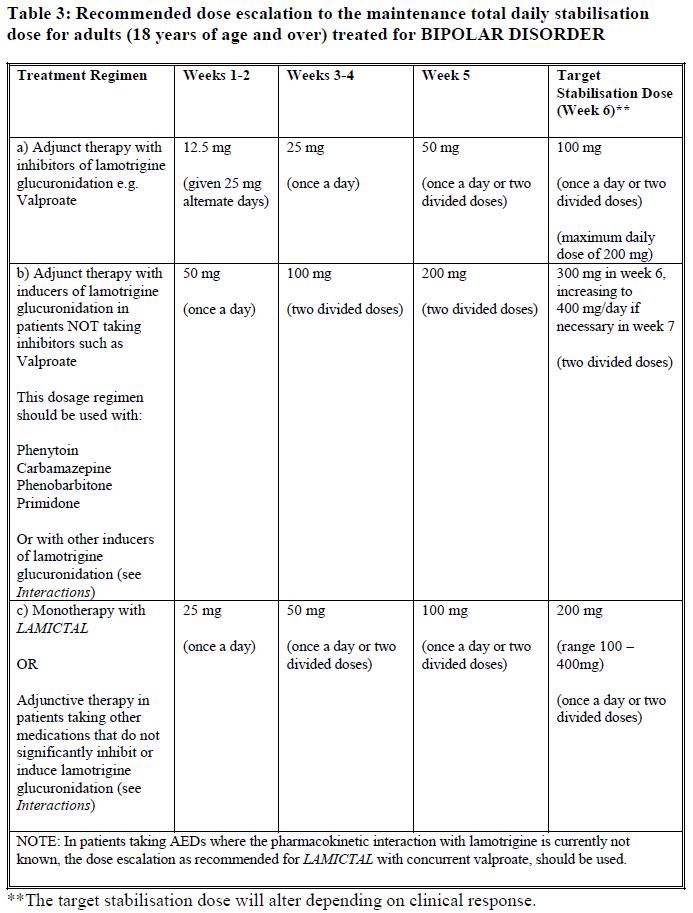 1. **Adjunct therapy with inhibitors of lamotrigine glucuronidation e.g. Valproate.** In patients taking glucuronidation inhibiting concomitant drugs such as valproate, the initial _LAMICTAL_ dose is 25 mg every alternate day for two weeks, followed by 25 mg once a day for two weeks. The dose should be increased to 50 mg once a day (or in two divided doses) in week 5. The usual target dose to achieve optimal response is 100 mg/day given once a day or in two divided doses. However, the dose can be increased to a maximum daily dose of 200 mg, depending on clinical response. 2. **Adjunct therapy with inducers of lamotrigine glucuronidation in patients NOT taking inhibitors such as Valproate. This dosage regimen should be used with phenytoin, carbamazepine, phenobarbitone, primidone and other drugs known to induce lamotrigine glucuronidation (see _Interactions_** – _please refer to the Product Insert/Patient Information Leaflet published on HSA for the full drug information_ **).** In those patients currently taking drugs that induce lamotrigine glucuronidation and NOT taking valproate, the initial _LAMICTAL_ dose is 50 mg once a day for two weeks, followed by 100 mg/day given in two divided doses for two weeks. The dose should be increased to 200 mg/day given as two divided doses in week 5. The dose may be increased in week 6 to 300 mg/day however, the usual target dose to achieve optimal response is 400 mg/day given in two divided doses which may be given from week 7. 3. **Monotherapy with _LAMICTAL_ OR adjunctive therapy in patients taking other medications that do not significantly induce or inhibit lamotrigine glucuronidation (see _Interactions_** – _please refer to the Product Insert/Patient Information Leaflet published on HSA for the full drug information_ **).** The initial _LAMICTAL_ dose is 25 mg once a day for two weeks, followed by 50 mg once a day (or in two divided doses) for two weeks. The dose should be increased to 100 mg/day in week 5. The usual target dose to achieve optimal response is 200 mg/day given once a day or as two divided doses. However, a range of 100 to 400 mg was used in clinical trials. Once the target daily maintenance stabilisation dose has been achieved, other psychotropic medications may be withdrawn as laid out in the dosage schedule below (see Table 4). 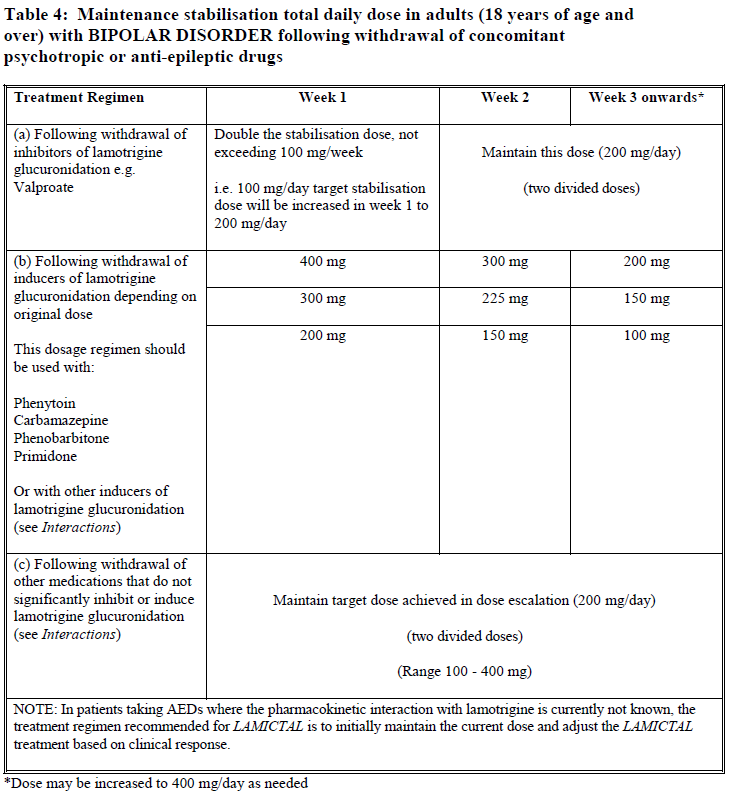 1. **Following withdrawal of adjunct therapy with inhibitors of lamotrigine glucuronidation e.g. valproate.** The dose of _LAMICTAL_ should be increased to double the original target stabilisation dose and maintained at this, once valproate has been terminated. 2. **Following withdrawal of adjunct therapy with inducers of lamotrigine glucuronidation depending on original maintenance dose. This regimen should be used with phenytoin, carbamazepine, phenobarbitone, primidone or other drugs known to induce _LAMICTAL_ glucuronidation (see _Interactions_** – _please refer to the Product Insert/Patient Information Leaflet published on HSA for the full drug information_ **).** The dose of _LAMICTAL_ should be gradually reduced over three weeks as the glucuronidation inducer is withdrawn. 3. **Following withdrawal of adjunct therapy with other medications that do not significantly inhibit or induce lamotrigine glucuronidation (see _Interactions_** – _please refer to the Product Insert/Patient Information Leaflet published on HSA for the full drug information_ **).** The target dose achieved in the dose escalation programme should be maintained throughout withdrawal of the other medication. **Adjustment of _LAMICTAL_ daily dosing in patients with BIPOLAR DISORDER following addition of other medications** There is no clinical experience in adjusting the _LAMICTAL_ daily dose following the addition of other medications. However, based on drug interaction studies, the following recommendations can be made (see Table 5 below): 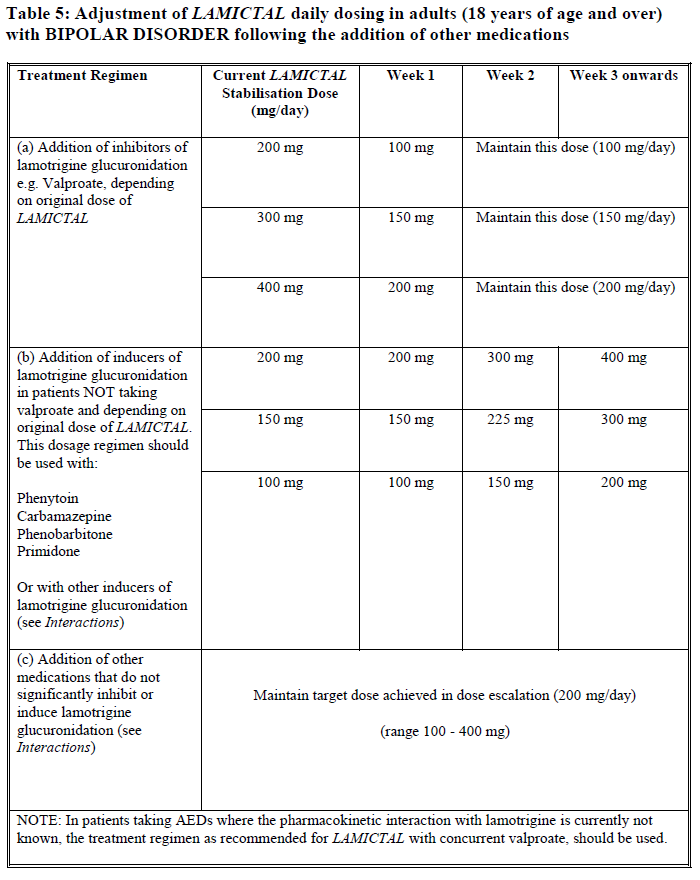 **Discontinuation of _LAMICTAL_ in adult patients with BIPOLAR DISORDER** In clinical trials, there was no increase in the incidence, severity or type of adverse experiences following abrupt termination of _LAMICTAL_ versus placebo. Therefore, patients may terminate _LAMICTAL_ without a step-wise reduction of dose. - **Children and adolescents (less than 18 years of age)** _LAMICTAL_ is not indicated for use in bipolar disorder in children and adolescents aged less than 18 years (see _Warnings and Precautions_ – _please refer to the Product Insert/Patient Information Leaflet published on HSA for the full drug information_). Safety and efficacy of _LAMICTAL_ in bipolar disorder has not been established in this age group. Therefore, a dosage recommendation cannot be made. **GENERAL DOSING RECOMMENDATIONS FOR _LAMICTAL_ IN SPECIAL PATIENT POPULATIONS** - **Women taking hormonal contraceptives** 1. **Starting _LAMICTAL_ in patients already taking hormonal contraceptives:** Although an oral contraceptive has been shown to increase the clearance of lamotrigine (see _Warnings and Precautions & Interactions_ – _please refer to the Product Insert/Patient Information Leaflet published on HSA for the full drug information_), no adjustments to the recommended dose escalation guidelines for _LAMICTAL_ should be necessary solely based on the use of hormonal contraceptives. Dose escalation should follow the recommended guidelines based on whether lamotrigine is added to an inhibitor of lamotrigine glucuronidation e.g. valproate; whether _LAMICTAL_ is added to an inducer of lamotrigine glucuronidation e.g. carbamazepine, phenytoin, phenobarbital, primidone, rifampin or lopinavir/ritonavir; or whether _LAMICTAL_ is added in the absence of valproate, carbamazepine, phenytoin, phenobarbital, primidone, rifampicin or lopinavir/ritonavir ( _see Table 1 for epilepsy and Table 3 for bipolar disorder patients_). 2. **Starting hormonal contraceptives in patients already taking maintenance doses of _LAMICTAL_ and NOT taking inducers of lamotrigine glucuronidation:** The maintenance dose of _LAMICTAL_ will in most cases need to be increased by as much as two-fold (see _Warnings and Precautions & Interactions_ – _please refer to the Product Insert/Patient Information Leaflet published on HSA for the full drug information_). It is recommended that from the time that the hormonal contraceptive is started, the lamotrigine dose is increased by 50 to 100 mg/day every week, according to the individual clinical response. Dose increases should not exceed this rate, unless the clinical response supports larger increases. 3. **Stopping hormonal contraceptives in patients already taking maintenance doses of _LAMICTAL_ and NOT taking inducers of lamotrigine glucuronidation:** The maintenance dose of _LAMICTAL_ will in most cases need to be decreased by as much as 50% (see _Warnings and Precautions & Interactions_ – _please refer to the Product Insert/Patient Information Leaflet published on HSA for the full drug information_). It is recommended to gradually decrease the daily dose of lamotrigine by 50 to 100 mg each week (at a rate not exceeding 25% of the total daily dose per week) over a period of 3 weeks, unless the clinical response indicates otherwise. - **Elderly (over 65 years of age)** No dosage adjustment from recommended schedule is required. The pharmacokinetics of _LAMICTAL_ in this age group do not differ significantly from a non-elderly adult population. As older patients are more likely to suffer from intercurrent illness and require medications to treat other medical conditions, lamotrigine should be used cautiously in these patients and they should be monitored regularly. - **Hepatic impairment** Initial, escalation and maintenance doses should generally be reduced by approximately 50% in patients with moderate (Child-Pugh grade B) and 75% in severe (Child-Pugh grade C) hepatic impairment. Escalation and maintenance doses should be adjusted according to clinical response (see _Pharmacokinetics_ – _please refer to the Product Insert/Patient Information Leaflet published on HSA for the full drug information_). - **Renal impairment** Caution should be exercised when administering _LAMICTAL_ to patients with renal failure. For patients with end-stage renal failure, initial doses of _LAMICTAL_ should be based on patients' AED regimen; reduced maintenance doses may be effective for patients with significant renal functional impairment (see _Warnings and Precautions_ – _please refer to the Product Insert/Patient Information Leaflet published on HSA for the full drug information_). For more detailed pharmacokinetic information (see _Pharmacokinetics_ – _please refer to the Product Insert/Patient Information Leaflet published on HSA for the full drug information_).
ORAL
Medical Information
**Indications** **EPILEPSY** - **Adults and Adolescents (over 12 years of age)** _LAMICTAL_ is indicated for use as adjunctive or monotherapy in the treatment of epilepsy, for partial seizures and generalised seizures, including tonic-clonic seizures and the seizures associated with Lennox-Gastaut syndrome. - **Children (2 to 12 years of age)** _LAMICTAL_ is indicated as adjunctive therapy in the treatment of epilepsy, for partial seizures and generalised seizures including tonic-clonic seizures and the seizures associated with Lennox-Gastaut syndrome. Initial monotherapy treatment in newly diagnosed paediatric patients is not recommended. After epileptic control has been achieved during adjunctive therapy, concomitant anti-epileptic drugs (AEDs) may be withdrawn and patients continued on _LAMICTAL_ monotherapy. _LAMICTAL_ 2 mg dispersible/chewable tablet is not available locally. If the calculated dose in children is less than 2.5 mg daily, then _LAMICTAL_ cannot be used. DO NOT attempt to administer partial quantities of the dispersible/chewable tablets. **BIPOLAR DISORDER** - **Adults (18 years of age and over)** _LAMICTAL_ is indicated for the prevention of depressive episodes in patients with bipolar disorder. Safety and efficacy of _LAMICTAL_ in the acute treatment of mood episodes has not been established. The physician who elects to use _LAMICTAL_ for periods extending beyond 18 months should periodically re-evaluate the long-term usefulness of the drug for the individual patient.
**Contraindications** _LAMICTAL_ tablets and dispersible/chewable tablets are contraindicated in individuals with known hypersensitivity to lamotrigine or any other ingredient of the preparation.
N03AX09
lamotrigine
Manufacturer Information
GLAXOSMITHKLINE PTE LTD
Delpharm Poznań S.A.
GlaxoSmithKline Australia Pty Ltd (Packager)
Active Ingredients
Documents
Package Inserts
Lamictal PI.pdf
Approved: July 7, 2021
